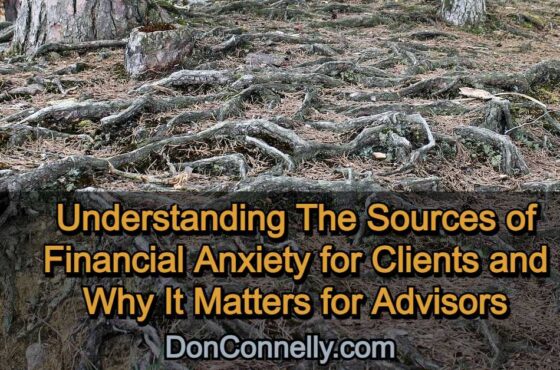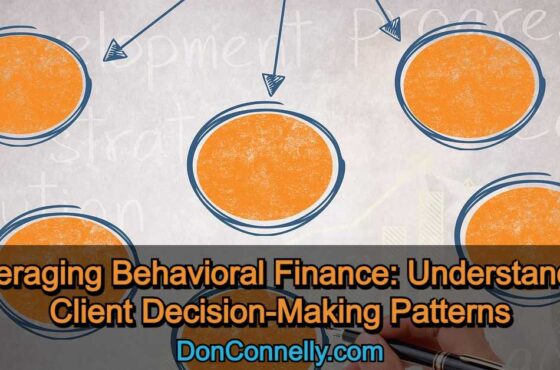How to Regain the Trust of a Client After a Disagreement
 Can you think of any relationship that has never experienced conflict—where two people with the best of intentions fail to see eye to eye on an issue? Such is the nature of relationships, even where there is a track record of trust. You expect it in a marriage and even among colleagues—so why not between a financial advisor and their client?
Can you think of any relationship that has never experienced conflict—where two people with the best of intentions fail to see eye to eye on an issue? Such is the nature of relationships, even where there is a track record of trust. You expect it in a marriage and even among colleagues—so why not between a financial advisor and their client?
It happens more than you might think. Financial advisors are wired to be analytical, while clients are often driven by emotion, which sets the stage for many “reality vs. perception” standoffs.
There’s the client who suddenly becomes frustrated that their portfolio isn’t beating the S&P 500 index. Or the client who becomes distraught over losses in their portfolio and wants to move their money into cash. Then there’s the client who doesn’t agree with the advice or recommendation you’ve given.
These are just a few examples where reality is often at odds with perception. When that perception gap is allowed to linger, it can lead to a breakdown in trust. It is sometimes the catalyst for a client to leave their advisor.
In many cases, a financial advisor can talk a client down from their emotional ledge and regain their trust by working through the disagreement. That may prove more challenging if the client decides to leave the advisor, but it is worth the effort if the conflict is based on some misunderstanding.
If a conflict arises, always stay calm and avoid becoming defensive. While resolving the conflict will put your communication skills to the test, your chances of success can increase by following these steps.
#1. Acknowledge the disagreement
Start by acknowledging the disagreement and taking responsibility for any role you might have played. This shows your client that you’re willing to be open and honest about the situation.
#2. Apologize if necessary
If your actions contributed to the disagreement, offer a sincere apology. This demonstrates humility and a commitment to making things right.
#3. Communicate openly
Take the lead on initiating an open and honest conversation about the disagreement. Your most powerful tool is to listen actively, allowing them to express their concerns and feelings without interruption. Stay attentive and take notes. Then play back what you heard to the client.
#4. Demonstrate empathy
Your second most powerful communication tool is empathy—putting yourself in your client’s shoes to try and understand their point of view. Empathy helps bridge the emotional gap that might have opened up during the disagreement.
#5. Clarify misunderstandings
In many cases, disagreements arise due to misunderstandings or miscommunications. Step in to clarify any misconceptions that might have contributed to the disagreement.
#6. Add context
Explain the circumstances that led to the disagreement from your perspective. Helping your client understand the context can help them see the situation from a different angle.
#7. Share your intentions
Reiterate your commitment to your client’s financial well-being and dedication to helping them achieve their goals, emphasizing that your intentions have always been aligned with their best interests. This might be where you refocus your client on their financial plan and how it’s designed to help them achieve their goals.
#8. Offer solutions
Show your commitment to resolving the conflict by proposing practical solutions that address the issues. You might consider adjusting their plan to suit their emotional temperament.
#9. Rebuild confidence
Outline the steps you will take to prevent disagreements in the future, highlighting changes you will make to improve transparency and communication. That might mean more frequent communications.
#10. Respect their decision
If your client needs time to process the situation or is not ready to move forward immediately, respect their decision. Give them the space they need while making yourself available if they wish to resume the relationship.
#11. Follow up
Check in with your client regularly to ensure that the changes you’ve implemented are working to their satisfaction and that they feel comfortable moving forward.
#12. Be willing to compromise
Resolving conflicts is not about being right. It’s about trying to move things forward. Sometimes your best option is to work out a compromise, finding a point of agreement between what they want and what you can offer.
#13. Refocus your client on their financial plan
When dealing with client emotions, situations can be unpredictable. You might be able to prevent conflicts by keeping your client focused on what’s important—securing their financial future. Look for opportunities to demonstrate your value.
Anytime you’re in a relationship, you can expect conflicts. It’s human nature to disagree on points when perception doesn’t meet reality. While you can’t prevent it, you can be prepared to resolve it. Your communication skills are critical to demonstrating you care and that your primary concern is your client’s financial and emotional well-being.
The worst thing that can happen in a relationship is losing trust. As an advisor, you must continuously work to earn it and, in situations that lead to conflict, regain it.
Watch this 3-minute video to learn how our 24-step training program can help you take your business to the next level!
See program details and enroll today!
Available as a self-paced program (always open) and as a 12-week coaching program (open only a couple of times a year), this training will change the way you view your practice and will give you an enormous advantage over your competition. Select your format and enroll today!



